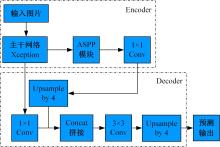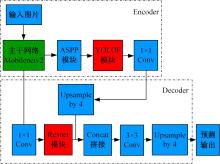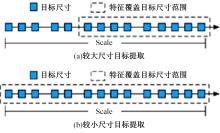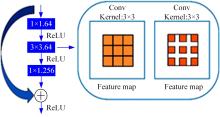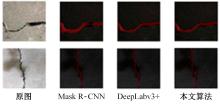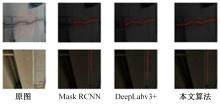Journal of Jilin University(Engineering and Technology Edition) ›› 2024, Vol. 54 ›› Issue (1): 173-179.doi: 10.13229/j.cnki.jdxbgxb.20220205
Bridge crack image segmentation method based on improved DeepLabv3+ model
Guo-jin TAN1( ),Ji OU1,Yong-ming AI1(
),Ji OU1,Yong-ming AI1( ),Run-chao YANG2
),Run-chao YANG2
- 1.College of Transportation,Jilin University,Changchun 130022,China
2.Jilin Provincial Highway Administration,Changchun 130021,China
CLC Number:
- U446
| 1 | 楼伟. 高等级公路路面病害识别与检测中的算法研究[D]. 西安:西安工业大学光电工程学院, 2001. |
| Lou Wei. Algodthm research on indentifies and detection the disease of highway surface[D]. Xi'an: School of Optoelectronic Engineering, Xi'an Polytechnic University, 2001. | |
| 2 | 王卫星, 吴林春. 基于分数阶积分谷底边界检测的路面裂缝提取[J]. 华南理工大学学报:自然科学版, 2014, 42(1): 117-122. |
| Wang Wei-xing, Wu Lin-chun. Extraction of pavement cracks based on valley edge detection of fractional integral[J]. Journal of South China University of Technology(Natural Science Edition), 2014, 42(1): 117-122. | |
| 3 | Zhao H L, Qin G F, Wang X J. Improvement of canny algorithm based on pavement edge detection[C]∥The 3rd International Congress on Image and Signal Processing, Yantai, China, 2010: 964-967. |
| 4 | Lim R S, La H M, Shan Z Y, et al. Developing a crack inspection robot for bridge maintenance [C]∥IEEE International Conference on Robotics and Automation, Shanghai, China, 2011: 6288-6293. |
| 5 | Tsai Y C, Kaul V, Mersereau R M. Critical assessment of pavement distress segmentation methods[J]. Journal of Transportation Engineering, 2010, 136(1): 11-19. |
| 6 | Zhang D J, Li Q Q, Chen Y, et al. An efficient and reliable coarse-to-fine approach for asphalt pavement crack detection[J]. Image and Vision Computing, 2017, 57: 130-146. |
| 7 | Cha Y J, Choi W, Buyukozturk O. Deep learning-based crack damage detection using convolutional neural networks[J]. Computer-Aided Civil and Infrastructure Engineering, 2017, 32(5): 361-378. |
| 8 | 李良福,马卫飞,李丽,等. 基于深度学习的桥梁裂缝检测算法研究[J]. 自动化学报, 2019, 45(9): 1727-1742. |
| Li Liang-fu, Ma Wei-fei, Li Li, et al. Research on detection algorithm for bridge cracks based on deep learning[J]. Acta Automatica Sinica, 2019, 45(9): 1727-1742. | |
| 9 | 蔡逢煌,张岳鑫,黄捷. 基于YOLOv3与注意力机制的桥梁表面裂痕检测算法[J]. 模式识别与人工智能, 2020, 33(10): 926-933. |
| Cai Feng-huang, Zhang Yue-xin, Huang Jie. Bridge surface crack detection algorithm based on YOLOv3 and attention mechanism[J]. Pattern Recognition and Artificial Intelligence, 2020, 33(10): 926-933. | |
| 10 | Jenkins M D, Carr T A, Iglesias M I, et al. A deep convolutional neural network for semantic pixel-wise segmentation of road and pavement surface cracks[C]∥The 26th European Signal Processing Conference, Rome, Italy, 2018: 2120-2124. |
| 11 | 朱苏雅, 杜建超, 李云松, 等. 采用U-Net卷积网络的桥梁裂缝检测方法[J]. 西安电子科技大学学报, 2019,46(4): 35-42. |
| Zhu Su-ya, Du Jian-chao, Li Yun-song, et al. Method for bridge crack detection based on the U-Net convolutional networks[J]. Journal of Xidian University, 2019, 46(4): 35-42. | |
| 12 | 刘承飞. 基于双卷积神经网络的桥梁裂纹实时检测技术研究[D]. 哈尔滨: 哈尔滨工业大学机电工程学院, 2020. |
| Liu Cheng-fei. Based on the double convolutional neural network research on real-time crack detection technology of bridge[D]. Harbin: School of Mechatronics Engineering, Harbin Institute of Technology, 2020. | |
| 13 | Krizhevsky A, Sutskever I, Hinton G E. ImageNet classification with deep convolutional neural networks [J]. Communications of the ACM, 2017, 60(6): 84-90. |
| 14 | Szegedy C, Liu W, Jia Y, et al. Going deeper with convolutions[C]∥IEEE Computer Society Conference on Computer Vision and Pattern Recognition, Boston,USA,2015: 1-9. |
| 15 | Szegedy C, Vanhoucke V, Ioffe S, et al. Rethinking the inception architecture for computer vision[C]∥IEEE Computer Society Conference on Computer Vision and Pattern Recognition, Las Vegas, USA,2016: 2818-2826. |
| 16 | Girshick R. Fast R-CNN[C]∥Proceedings of the IEEE International Conference on Computer Vision, Santiago, Chile, 2015: 1440-1448. |
| 17 | Ren S Q, He K M, Girshick R, et al. Faster R-CNN: towards real-time object detection with region proposal networks[J]. IEEE Transactions on Pattern Analysis and Machine Intelligence, 2017, 39(6): 1137-1149. |
| 18 | He K M, Gkioxari G, Dollar P, et al. Mask R-CNN[J]. IEEE Transactions on Pattern Analysis and Machine Intelligence, 2020, 42(2): 386-397. |
| 19 | He K M, Gkioxari G, Dollar P, et al. Mask R-CNN[C]∥IEEE International Conference on Computer Vision, Venice, Italy, 2017: 2980-2988. |
| 20 | Chen L C, Zhu Y K, Papandreou G, et al. Encoder-Decoder with atrous separable convolution for semantic image segmentation[C]∥European Conference Computer Vision, Munich, Germany, 2018: 833-851. |
| 21 | Chollet F. Xception: Deep learning with depthwise separable convolutions[C]∥The 30th IEEE Conference on Computer Vision and Pattern Recognition, Hawaii, USA, 2017: 1800-1807. |
| 22 | 苏可. 基于目标检测与语义分割的道路损伤识别方法[D]. 太原: 太原理工大学电气与动力工程学院, 2021. |
| Su Ke. Road damage recognition method based on target detection and semantic segmentation[D]. Taiyuan: School of Electrical and Power Engineering, Taiyuan University of Technology, 2021. |
| [1] | Ran AN,You-zhi WANG. Shear properties of shear stud connectors under combined tension and shear loading [J]. Journal of Jilin University(Engineering and Technology Edition), 2023, 53(9): 2554-2562. |
| [2] | Xin-dai ZUO,Jin-quan ZHANG,Shang-chuan ZHAO. Fatigue stiffness degradation and life prediction method of in⁃service concrete T⁃beams [J]. Journal of Jilin University(Engineering and Technology Edition), 2023, 53(9): 2563-2572. |
| [3] | Chun-li WU,Shi-ming HUANG,Kui LI,Zheng-wei GU,Xiao-ming HUANG,Bing-tao ZHANG,Run-chao YANG. Analysis of pier action effect under flood based on numerical simulation and statistical analysis [J]. Journal of Jilin University(Engineering and Technology Edition), 2023, 53(6): 1612-1620. |
| [4] | Zheng-wei GU,Pan ZHANG,Dong-ye LYU,Chun-li WU,Zhong YANG,Guo-jin TAN,Xiao-ming HUANG. Earthquake⁃induced residual displacement analysis of simply supported beam bridge based on numerical simulation [J]. Journal of Jilin University(Engineering and Technology Edition), 2023, 53(6): 1711-1718. |
| [5] | Guo-jin TAN,Qing-wen KONG,Xin HE,Pan ZHANG,Run-chao YANG,Yang-jun CHAO,Zhong YANG. Bridge scour depth identification based on dynamic characteristics and improved particle swarm optimization algorithm [J]. Journal of Jilin University(Engineering and Technology Edition), 2023, 53(6): 1592-1600. |
| [6] | Hui JIANG,Xin LI,Xiao-yu BAI. Review on development of bridge seismic structural systems: from ductility to resilience [J]. Journal of Jilin University(Engineering and Technology Edition), 2023, 53(6): 1550-1565. |
| [7] | Jun WANG,Jia-wu LI,Feng WANG,Jiu-peng ZHANG,Xiao-ming HUANG. Wind speed distribution in simplified U⁃shaped valley and its effect on buffeting response of long⁃span suspension bridge [J]. Journal of Jilin University(Engineering and Technology Edition), 2023, 53(6): 1658-1668. |
| [8] | Feng WANG,Shuang-rui LIU,Jia-ying WANG,Jia-ling SONG,Jun WANG,Jiu-peng ZHANG,Xiao-ming HUANG. Size and shape effects of wind drag coefficients for porous structures [J]. Journal of Jilin University(Engineering and Technology Edition), 2023, 53(6): 1677-1685. |
| [9] | Hua WANG,Long-lin WANG,Zi-mo ZHANG,Xin HE. Safety early warning technology of continuous rigid frame bridges based on crack width variation [J]. Journal of Jilin University(Engineering and Technology Edition), 2023, 53(6): 1650-1657. |
| [10] | Yu FENG,Jian-ming HAO,Feng WANF,Jiu-peng ZHANG,Xiao-ming HUANG. Analysis of transient wind⁃induced response of long⁃span bridge under nonstationary wind field [J]. Journal of Jilin University(Engineering and Technology Edition), 2023, 53(6): 1638-1649. |
| [11] | Ye YUAN. Natural frequency analysis of beam bridge structure under temperature and vehicle action [J]. Journal of Jilin University(Engineering and Technology Edition), 2023, 53(6): 1702-1710. |
| [12] | Zi-yu LIU,Shi-tong CHEN,Mo-mo ZHI,Xiao-ming HUANG,Zhe-xin CHEN. Ultimate bearing capacity of temporary⁃permanent conversion rush⁃repair steel pier for emergency use [J]. Journal of Jilin University(Engineering and Technology Edition), 2023, 53(6): 1601-1611. |
| [13] | Yue ZHANG,Chuan-sen LIU,Fei SONG. Influence of abutment back wall on continuous girder bridge's seismic fragility [J]. Journal of Jilin University(Engineering and Technology Edition), 2023, 53(5): 1372-1380. |
| [14] | Shu-wei LAN,Dong-hua ZHOU,Xu CHEN,Nan-ming MO. Practical calculation method for the critical bearing capacity of double column bridge with high piers [J]. Journal of Jilin University(Engineering and Technology Edition), 2023, 53(4): 1105-1111. |
| [15] | Qi-kai SUN,Nan ZHANG,Xiao LIU,Zi-ji ZHOU. Dynamic reduction coefficients of steel⁃concrete composite beam based on Timoshenko beam theory [J]. Journal of Jilin University(Engineering and Technology Edition), 2023, 53(2): 488-495. |
|
||
